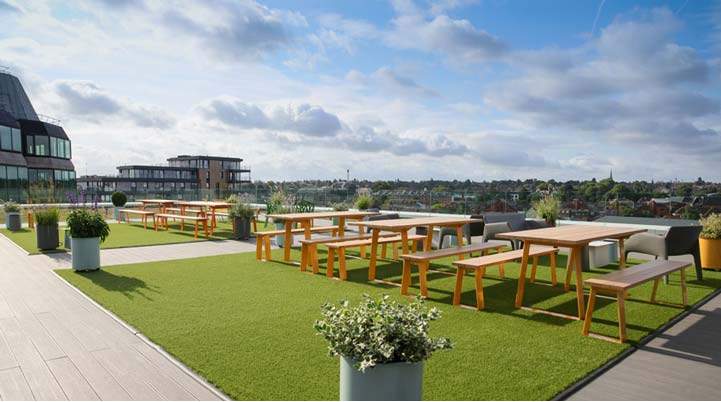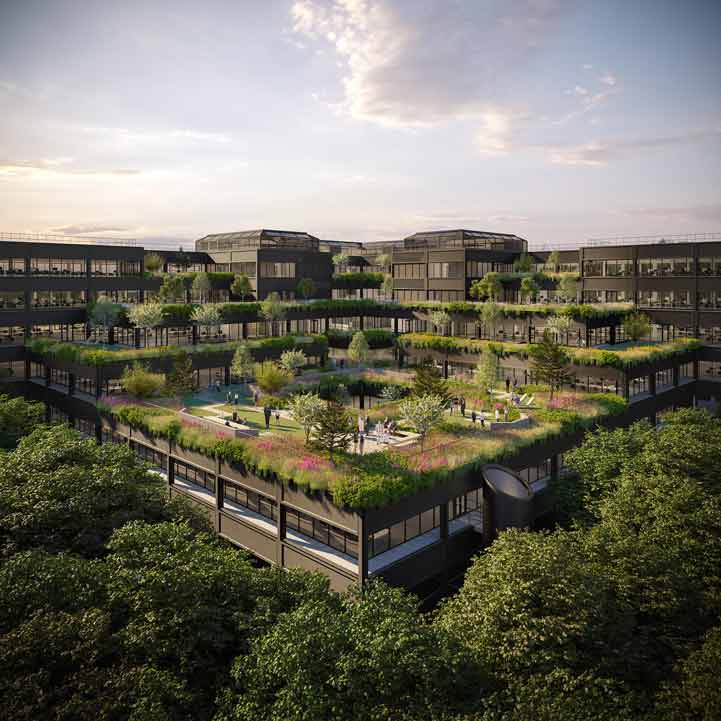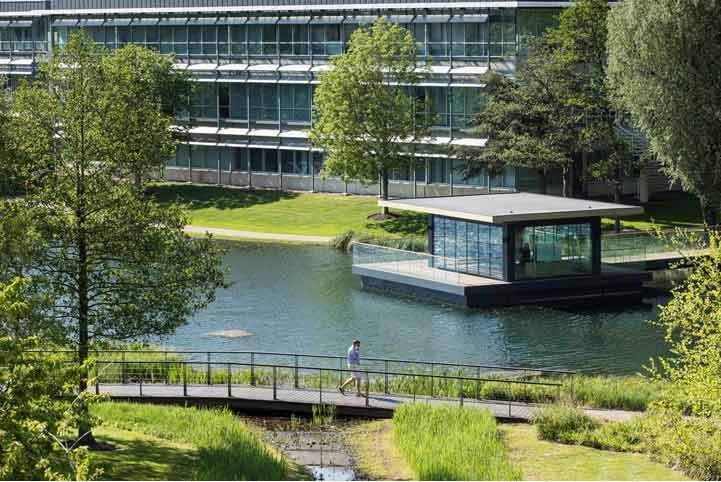In order to promote wellbeing and staff demands, developers and occupiers are increasing the provision of green space in their office buildings
demand for green space rising
The demand for green space from office workers is rising which was uncovered by Savills 2019 What Workers Want survey. This was notable in all regions but was most apparent in the Thames Valley where 70% of respondents placed a high importance on access to green space. This represented a 25 percentage point increase from Savills 2016 What Workers Want Survey highlighting the attitude changes towards our immediate environment. Developers and occupiers are responding to this demand by increasing the provision of green space inside or surrounding their office buildings.
The large landscaped business parks in the Thames Valley are well placed to satisfy this need and are able to provide a scenic environment for office workers to work and thrive within.
In the UK, the Thames Valley placed the highest importance on proximity to green space in Savills What Workers Want 2019 survey
Savills Research
In dense urban environments, where green space is limited, there are techniques which landlords and tenants can use, to enhance the sense of nature within a building. One of these is to adopt and encourage a biophilic design in an office building. Biophilia was a term developed by American biologist Edward Wilson which he defined as “the urge to affiliate with other forms of life.” Opposed to phobias, philias are attractions and positive feelings that people have towards their natural surroundings.
Biophilic design in office buildings is not solely increasing the provision of plants but it also includes improving the quality of access to natural light and the air quality.
While it can be challenging to incorporate natural elements into a building there are subtle changes that can be made to replicate natural elements. These include interior lighting changes and adopting smart technologies that can modify air ventilation as well as natural finishes such as wood.
Biophilic design can heighten and stimulate emotional and intellectual senses which can act as a catalyst to forming a connection between people (employees) and place (office building) and consequently reduce stress levels amongst office workers. If employees associate their office building with positive memories and emotions it is more likely that their wellbeing will be improved, increasing happiness and productivity.
Lighting and air quality were amongst the most important factors for office workers in their ideal workspace whereas only 52% and 44% of respondents were highly satisfied with lighting and air quality. This underlines the need for landlords and occupiers to ensure that these issues are being actively addressed. The property industry is rewarding good practices of biophilic design through various certifications. Industry certifications such as The WELL Building Standards and Fitwel are becoming more prominent and can act as a key attractor for occupiers.

The White Building, Reading has a 3,143 sq ft communal roof terrace
Roof terraces can be a method to improve the access to green space in urban centres and provide a different area for office workers to work within the building, which is also factor in improving employee wellbeing. Only 9% of respondents across the UK were satisfied with the provision of roof terraces, which highlights room for improvement in this area. The White Building, Reading which was speculatively comprehensively refurbished and achieved practical completion in 2017, has a communal roof terrace (3,143 sq ft) which tenants can use at lunchtimes and host informal meetings. The roof terrace can also be used as events space for hosting networking events and can be used to encourage collaboration between tenants within the building. Another example of good practice of biophilic design is Mountbatten House, Basingstoke which is being comprehensively refurbished by Squarestone Growth. The listed building will have roof terraces on every floor and large communal gardens.

A CGI image of Mountbatten House, Basingstoke which is being comprehensively refurbished by Squarestone Growth
There are other alternatives to roof terraces in providing outdoor building space. APAM & Patron Capital have developed a floating pavilion at Arlington Business Park, Theale. This was the first of its kind in the UK and provides a shared meeting, conference and event space. Academic studies have revealed that office workers feel relaxed and stimulated when they are in proximity to water.
Savills What Workers Want survey revealed that the internal design and fit out was the highest scoring factor that office workers would most like to change. Incorporating a biophilic design to the building is relatively cost effective and can be viewed as an easy win to improving employee wellbeing. Only 24% and 25% of respondents were satisfied with the provision of plants and greenery inside the office and their access to outside building space. There is clear improvement to be made in satisfying this demand. Savills What Workers Want survey uncovered that 68% of office workers who were not satisfied with the provision of plants and greenery in the office reported that their workplace had a negative impact on their mental and physical health.

APAM and Patron Capital developed a floating pavilion at Arlington Business Park, Theale which provides outdoor meeting space
HR professionals are becoming more involved in real estate relocations and are using real estate as a productivity tool
Savills Research
Critics of biophilic design will argue that there is limited empirical data to quantify the impact. There are numerous academic studies which suggest that there is a correlation between rising productivity levels and improvements in natural light, air quality and greenery in office buildings. The UK has the lowest productivity rate in Europe and Deloitte’s 2017 study supporting the Stevenson/Farmer Review found that mental health-related presenteeism alone costs UK businesses roughly £17 billion to £26 billion every year. Using real estate as a productivity tool is rising on the corporate agenda. HR professionals and advisors are becoming more involved in real estate relocations and are expecting more from than their real estate. Easy wins which landlords and occupiers can implement in their office building such as biophilic design which can improve wellbeing and productivity should be actively encouraged.
.jpg)